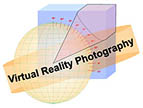
Film vs. Digital for Panorama Capture
 | Film vs. Digital for Panorama Capture |
![]() (Updated March, 2005)
(Updated March, 2005)
The film vs. digital question has been around since the earliest days of digital photography. It is one that every photographer will face at some point. Today, there are compelling advantages to both, particularly as the image quality of digital cameras increase and their prices decrease. As with almost everything else in photography, there are tradeoffs no matter which way you decide. For most VR photographers, panoramic imaging represents only a portion of their work, so the factors that lead them to choose film or digital for their panoramic photography may not be as relevant for the other types of photography they do.
To help in the decision making process, here is a chart listing advantages and disadvantages of both film and digital capture for panoramic photographers. These arguments are based on current technologies, and are likely to change as both film and digital technologies continue to evolve.
![]()
| Film | Digital | |
| Field of view | Pro: Full field of view. | Con: Limited field of view with same lenses, except newest pro models. |
| Color balance | Con: requires matching of film type to lighting ad use of color correction (cc) filters. | Pro: Auto white balancing is generally sufficient for color correction, even under mixed lighting. |
| Exposure latitude | Pro: Wide latitude for negative film (7-9 stops). Con: Narrow latitude for transparency film (5 stops). | Pros: high end (expensive) cameras offer broad exposure latitudes similar to (or better than) negative films. Con: Consumer level (less expensive) cameras have narrower latitudes similar to transparency films. |
| Capture speed | Pros: Extremely fast during shooting. Cons: Requires scanning for post production. | Pros: High end cameras capable of rapid shooting for limited bursts. Con: Consumer cameras often require long delays (10-30 seconds) between shots while previous image(s) are being saved. |
| Resolution | Pros: Very fine - depending upon film used. Can be used to create wall sized panoramic prints and show fine detail. Film can be scanned at any resolution needed. | Cons: Limited resolution compared to film, except for high end (expensive) digital cameras. Consumer cameras are generally limited to full page or less reproduction. |
| Equipment costs (camera, lens, pan head) | Professional: $1,200 - $7,500. Consumer: $750 - $1,000. | Professional: $2,500 - $9,000. Consumer: $1,000 - $1,500. |
| Film, processing & scanning costs | $5 - $35/node | None |
| Work flow & post production | Cons: Scanning slows down post production speed & adds cost. | Pros: Can stitch or assemble on location with laptop computer, if needed. Images are digital from the outset – requiring no scanning. |
| Portability & durability in the field | Good to excellent. | Poor to good, depending upon model. |
| Obsolescence period | Pro: 35mm cameras & lenses retain value fairly well over 5–10 year period. | Con: Digital systems can lose value quickly (up to 50% or more each year). |
| Stitching technologies (QTVR) | Pros: Relatively high quality and resolution possible, variety of software authoring applications available, can be viewed on any computer with industry standard QuickTime™ installed. Cons: Requires 8-12 photos (or more) for each panorama, more for multi-row (cubic) panos. Cubic viewing requires that viewers have a recent version of QuickTime installed, although this is already standard on most computers. | Pros: Same advantages as film. Cons: Same disadvantages as film, but digital capture generally requires more source images per panorama in order to yield same field of view as with film. |
| IPIX technology | Pros: requires only two or three images per panorama, offers 360°x360° views with every panorama. Cons: Requires annual license fee for software use. Need special fisheye lenses to shoot, limited maximum resolution compared to QTVR, users must have IPIX™ plug-in or IPIX viewer installed (free), authoring software available only from IPIX. | Pros: Same advantages as film. Cons: Same disadvantages as film, but with lower maximum resolution (except for extremely high end/expensive digital systems). |
| Slit-scan camera systems (Roundshot, Panoscan, Spheron, etc.) | Pros: Can capture 360° images seamlessly and faster than traditional multiple shot cameras, panoramas require no stitching, can provide the highest resolution panoramic imagery. Cons: Expensive, difficult to use when supplemental lighting is required, film-based models not usually capable of fisheye or 360°x360° coverage. | Pros: Same advantages as film, plus some digital models are capable of fisheye or 360°x360° images. Cons: Same disadvantages as film, although digital models are significantly more expensive than film models. Current digital models also require that a portable or laptop computer be tethered to the camera when in use. |
| Single Shot Systems (360One, BeHere, Remote Reality) | Pros: Captures full 360° panorama in single moment, can freeze action throughout scene, no stitching required, allows for rapid shooting of images and sequences. Cons: Low resolution, requires proprietary software for dewarping, hard to visualize resulting image when looking through viewfinder, not capable of 360°x360° views, limited exposure control while shooting. Some also require royalty payment or "processing service" fee for every image created. | Pro: Same advantages as film. Cons: Same disadvantages as film, but maximum resolution even further limited. |
![]()
For additional information about choosing a film or digital camera for panoramic VR capture: Ask the Experts
![]()